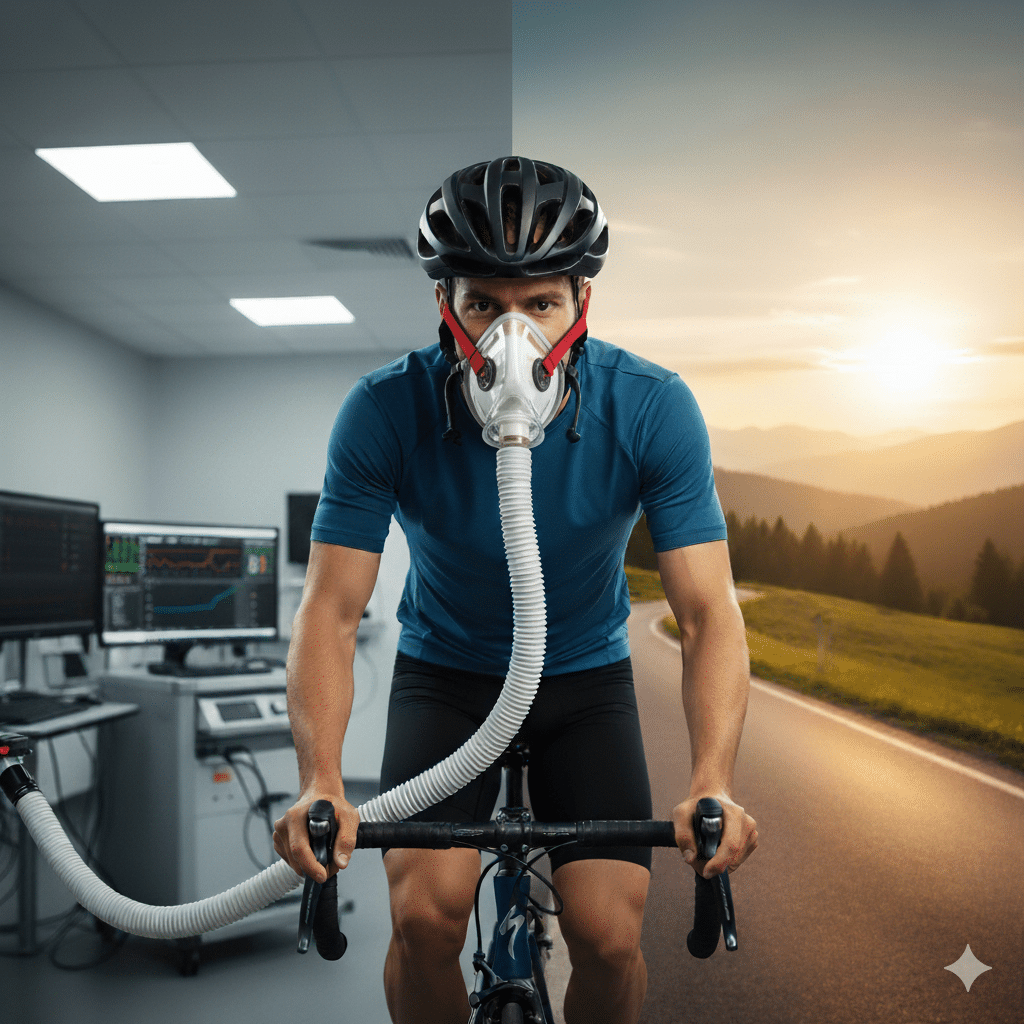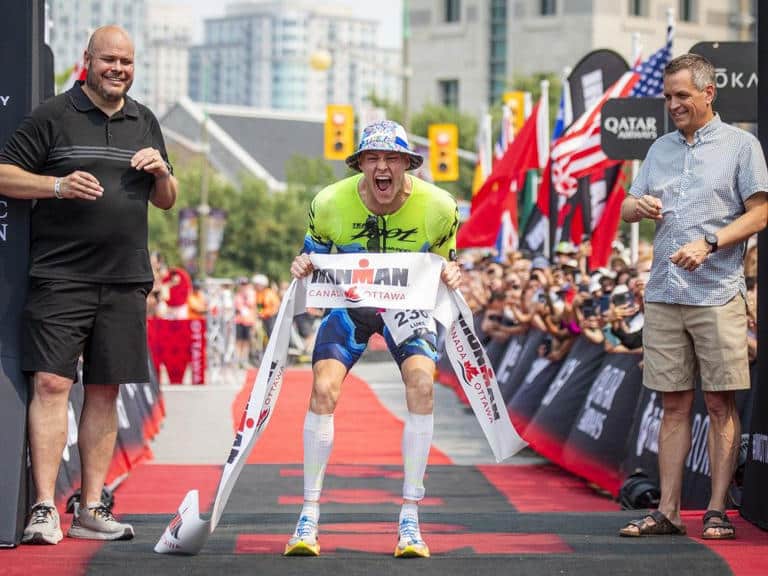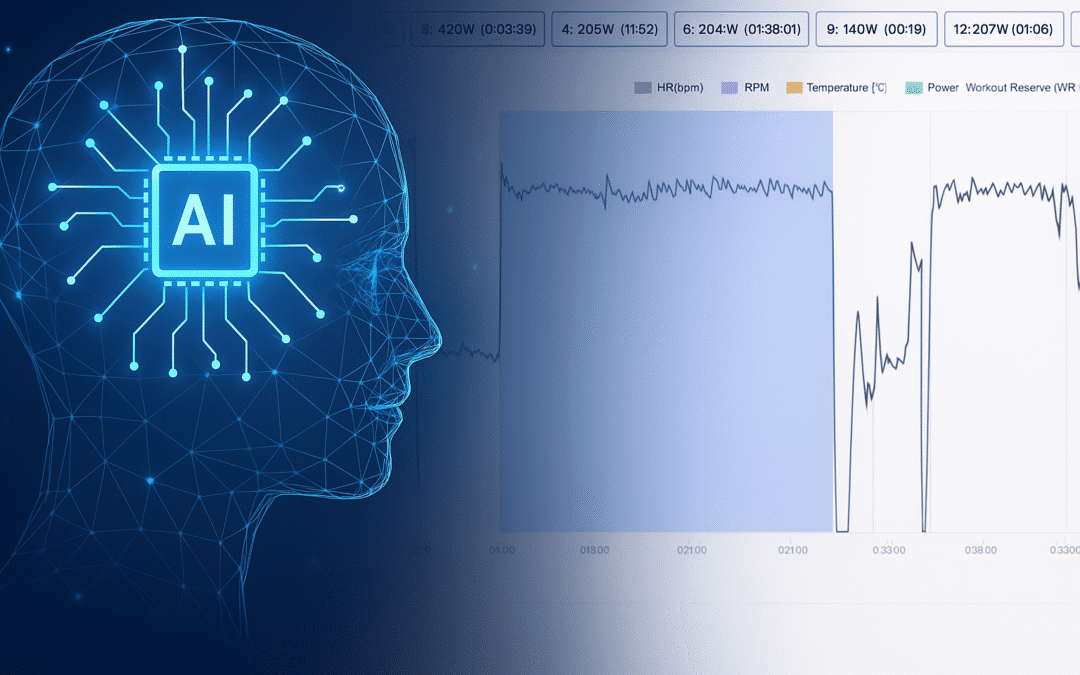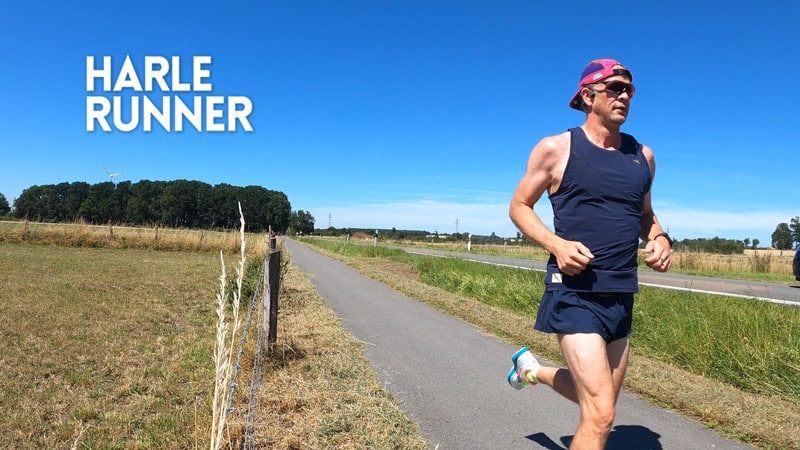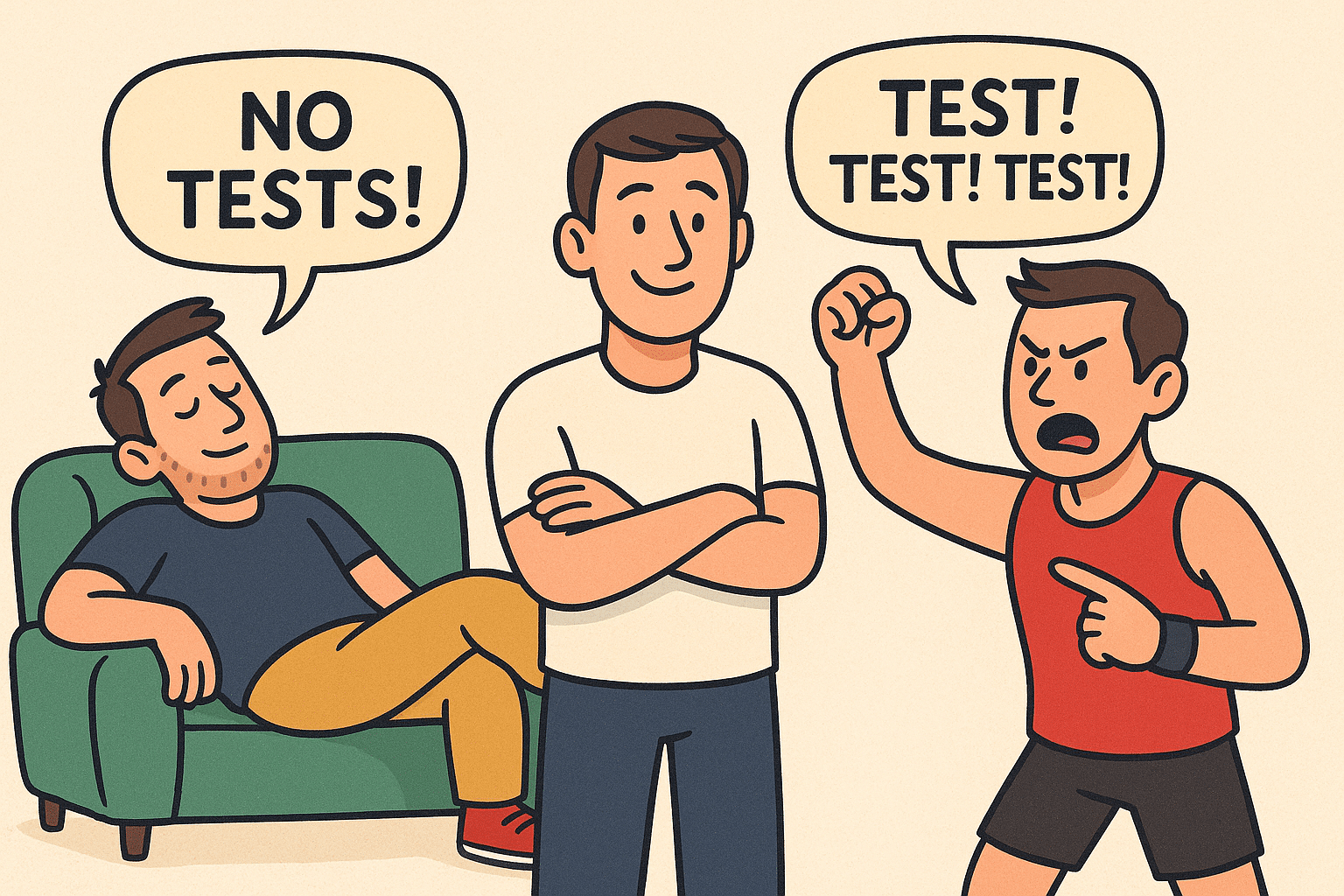
Figure 1: We designed Athletica to strike the balance between a classic testing approach, frequent, fixed-duration tests, and a no-max-test methodology. Maximal tests, after all, are often more about mental, emotional, and physical strain than pure performance measurement. They can be disruptive, yet they remain invaluable for tracking fluctuations in your performance potential. Athletica aims to minimize intrusiveness while still providing a robust estimation of your real capabilities, allowing you to monitor progress naturally, without unnecessary stress or disruption.
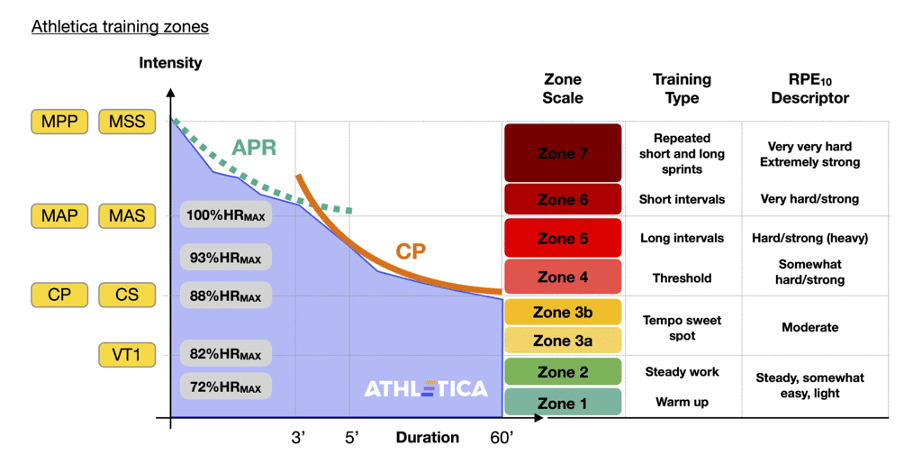
Figure 2. How Athletica takes your wearable data before converting it instantly to training zones and prescription. For more information, check out the blog: How Athletica Closes the Cycle: From Athlete Profiling to Training Prescription.
2) How Athletica closes the loop
| Step | What happens inside Athletica | Your job |
| Connect data | Sync Garmin, Strava, Wahoo, Coros, Concept2, intervals.icu. | One-time authorisation. |
| Generate profile | Critical power (or pace) and anaerobic power (or pace) reserve model curve + 6-week WR baseline. | Review your Session Analysis or real time WR Garmin IQ App or indoor Velocity trainer readout. |
| Detect gaps | Algorithm spots durations with sparse maximal data. | Decide between a full Test Week or a single test from the Global Library. |
| Run the test(s) | New maximal mean powers (MMPs) or WR values drop straight into the database. | Follow AI-Coach session prompts on Athletica. |
| Auto-update zones & plan | 7 zones (and future workouts) scale in seconds. | Train on the refreshed targets. |
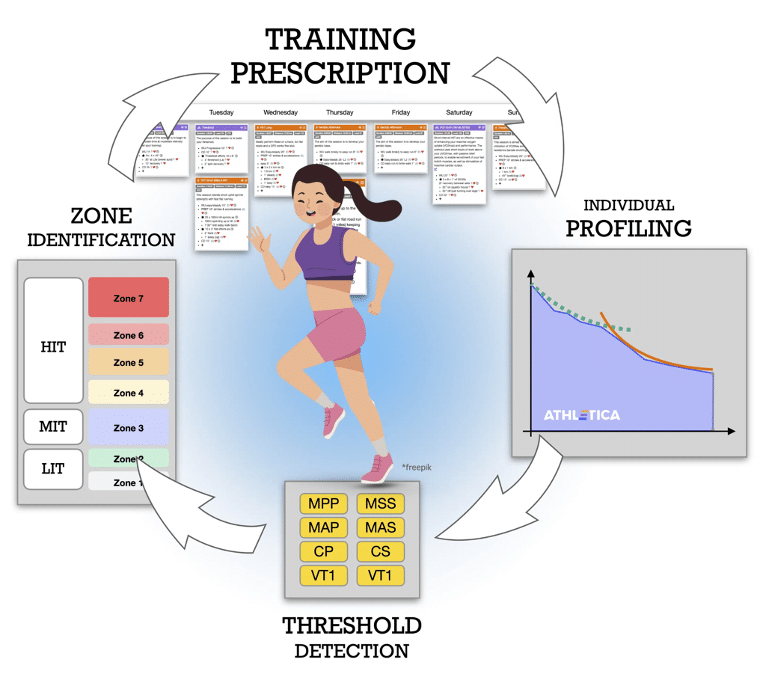
Figure 3. How Athletica closes the cycle, from athlete profiling to training prescription.
3) Universal protocols
3.1 ) Power / Pace Profile
Cycling: 4–7 maximal efforts (e.g., 6 s, 30 s, 1 min, 5 min, 10 min) populate the power-duration curve (a modified version of the protocol introduced in (Quod et al., 2010).
Running: 3 maximal efforts (e.g., 400m, 1k, 5k) populate the pace-duration curve. Running power supported via Stryd & Garmin.
Swimming: 2 maximal efforts (e.g., 400m, 50m) populate the pace-duration curve to form your critical swim speed (CSS).
Rowing: Up to 5 maximal efforts (e.g., 100m, 1k, 2k, 5k, 1hour) populate the power-duration curve.

Figure 4. The power profile test performed within Athletica cycling related test weeks. A modified version of the original Quod et al. (2010) methodology.
3.2) Zone 2 / MAF Test
• Zone 2 or MAF guidelines suggest 5 to 8 km (3 to 5 miles) running or 30 min of cycling at 180 – age bpm (or 130 bpm if ≥ 50 y).
• Decoupling (efficiency change calculated by Athletica) stays flat (< 2 % drop) when you’ve truly developed your fat burning ability (Maffetone & Laursen, 2020).
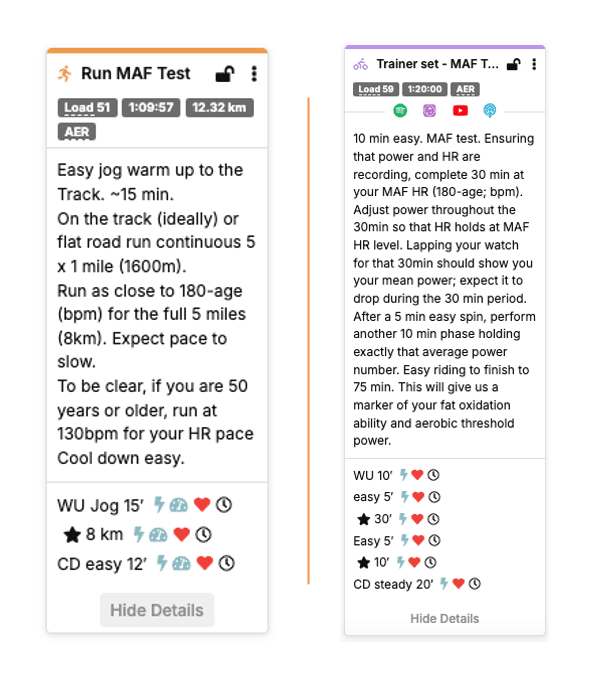
3.3) Reading Your Power / Pace Profile
Where appropriate, your AI-coach delivers call-outs that assess your strengths and work-ons as an athlete.
Assessment definitions
- Maximal aerobic power/speed (MAP/MAS): estimated from your data using your short-duration (<5-min) MMP/MMS data. Ideally, this marker is in line with the value you’d attain at the end of a progressive exercise test (i.e., VO2max test).
- Max peak power / max sprinting speed (MPP/MSS): a marker of your short duration sprint ability taken from your 10” MMP/MMS data.
- Peak-to-MAP/MAS ratio: the ratio between your MAP and your MPP (or your MAS and your MSS).
- Critical power/pace (CP): the boundary between Z3 and Z4, computed using your medium-duration (3’-60’) MMP/MMS data.
- CP-to-MAP ratio: the ratio between your CP and your MAP (or your CS and your MAS).
Example: short-duration power/pace deficit → Athletica’s AI-Coach suggests appropriate workouts you can select to improve the accuracy of the profile.
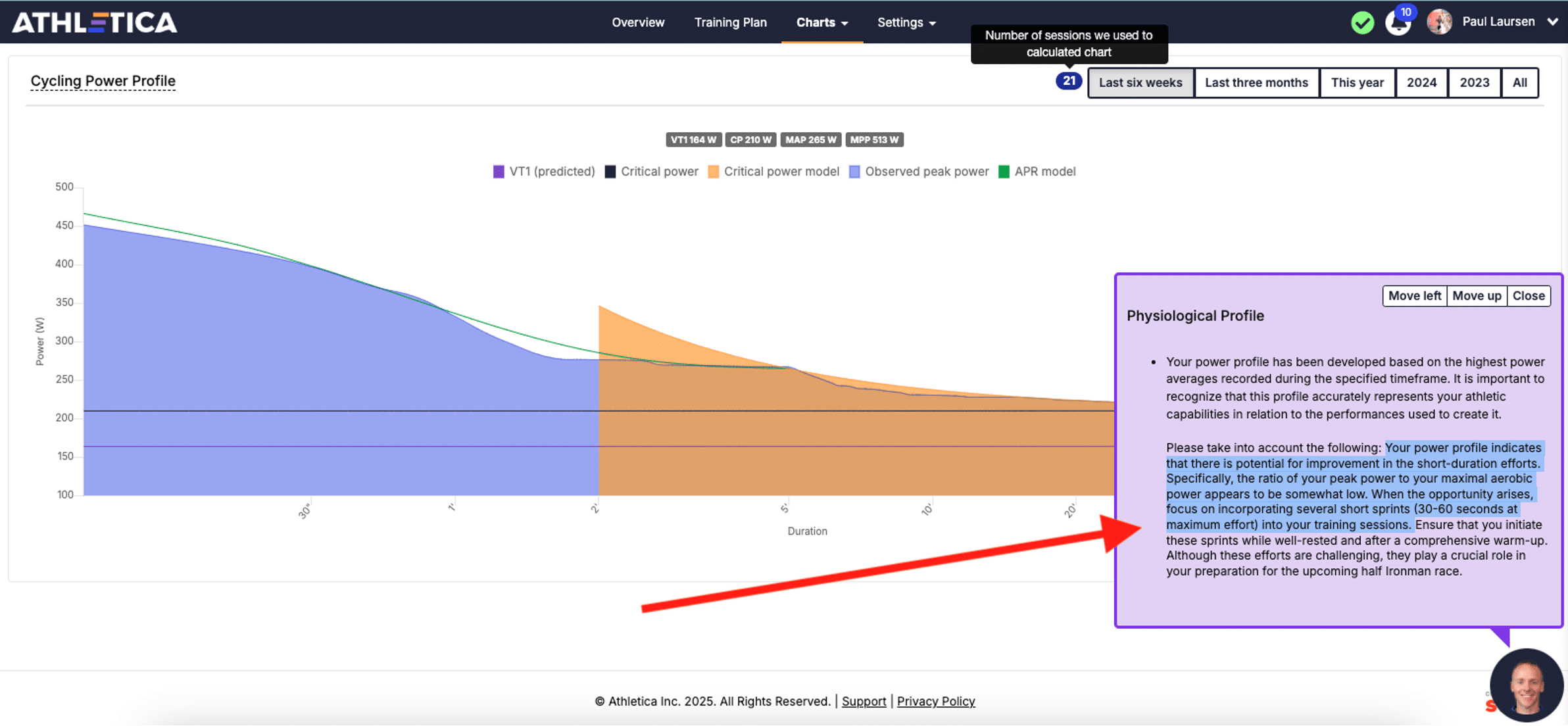
4) Sport-specific Test-Week playbooks
Each sport has its own demands, and the best way to capture them is with field tests tailored to your event. Below you’ll find the sample Test Week micro-cycles Athletica uses to fill gaps in your power or pace profile, establish your personal training zones, and set your plan up for success. Every test here ties straight back to your real-world racing needs.
Triathlon (+ Duathlon)
• Critical Swim Speed (400 m + 50 m) (triathlon only)
• FTP bike (20 min)
• 400 m + 1 km run TT
• Bike & Run MAF tests
• 5 km run TT

Cycling
• 30 min MAF
• 20 min FTP (uphill if possible)
• Seven-effort Power-Profile test

Running
• 400 m + 1 km TT
• 5 × 1 mile (or km) MAF test
• 5 km TT

Rowing
• 100 m + 1 km all-out
• 1′, 2 k, 6 k maximal rows

HYROX
• 400 m + 1 km TT
• 20 min FTP bike
• Run & Bike MAF tests
• 5 km TT
• 2 k row TT
• Foundational strength screen (squat, press, deadlift, core)

5) Frequently Asked Questions
What is a Test Week in Athletica?
A seven-day micro-cycle of sport-specific field tests that fills data gaps in your power/pace curve and recalibrates your zones
How do I sync Garmin, Coros, Wahoo, Strava or Concept2 data to Athletica?
Go to Settings → Connections, choose the connection, click Connect and authorise the data link.
How often should I repeat a Test?
Every 16 weeks or whenever you think your zones are off.
How can I insert a test in my training week?
To conduct a test, you must be in your best shape. Ideally, you would perform a test by substituting a highly-demanding session such as HIIT sessions using the global library of sessions. To do so: go on the selected day → Add from library → Select Global Library → Filter for “Testing” Session Aim and Modality → select one available and insert in the chosen day (e.g. Wednesday). Remove the existing session.
Will my training zones update automatically after I upload a test?
Yes, zones refresh within seconds and all scheduled workouts re-scale accordingly.
Do I need a power meter, or can I use heart-rate and pace only?
Power is preferred for cycling & rowing, but Athletica still recalibrates HR- and pace-based zones when power isn’t available.
How accurate is Workout Reserve compared with W′?
- WR integrates your maximal efforts across all intensities, making it more stable and representative than the short-effort-only W′ model, which is not taking into account the effects of durability on your physiological parameters. For the complete background on Workout Reserve, follow this link.
I’m new to HYROX, what’s the first test I should do?
Start with the HYROX 400 m + 1 km run TT and the 5 km run test; these anchor both aerobic and running speed demands of Hyrox.
How do I perform the Zone 2 MAF test correctly?
Warm-up, run/ride 20–30 min (5-8 km) at 180 – age bpm (or 130 bpm if 50+). Focus on holding the heart rate and expect pace/power to drop.
Can I swap a single session inside Test Week?
Yes, move all testing sessions to the day of your liking.
What if I miss a test because of illness?
Skip it; you’ll find all tests in Athletica’s Global Library and you can complete in the future at a time that better suits your schedule.
How do you calculate the APR? What model do you use?
The APR is computed by using the equations detailed in the work of Weyand (running) and Sanders (cycling). The model is used to derive the maximal sprinting speed or peak power (MSS/MPP), the maximal aerobic speed or power (MAS/MAP).
How do you calibrate the upper zones?
The upper zones are calibrated with APR: bottom Z5 is MAP (from above point, very close to the maximal mean speed or power that an athlete can sustain for 5 minutes) and upper Z5 is 120% of MAS/MAP. Bottom Z7 is 50% between top MAS/MAP and MSS/MPP. Yes, there might be a gap between Z6 and Z7 but there are reasons for it. Top Z7 is MPP (very close to the maximal mean speed or power that an athlete can sustain for 10”)
Are you using %APR to define your HIIT?
No, we are not defining HIIT with APR, although we are on our way to implement that option. We are using Z6 to prescribe 30”:30” HIIT SHORT aerobic sessions, and Z5 for LONG intervals (in line with HIIT Science book).
6) Further reading
- Athletica Blog: “How Athletica Closes the Cycle from Athlete Profiling to Training Prescription.”
- Workout Reserve Series (2024–2025) — deep-dives into the WR metric.
- Self-Coached Athlete Guide — using AI feedback without a human coach.
- Sprint Triathlon Pillar Article — example of a completed Test Week in action.
7) References
Athletica. (2024, July 31). How Athletica closes the cycle: From athlete profiling to training prescription. https://athletica.ai/how-athletica-closes-the-cycle-from-athlete-profiling-to-training-prescription/ athletica.ai
Athletica. (2024, June 6). Back to the future – Introducing the Workout Reserve. https://athletica.ai/athletica-workout-reserve-future-of-fitness/
Concept2 Integration Now Live. (2025). Athletica News. https://news.athletica.ai/posts/new-rowing-plans-concept-2-integration-now-live
Leduc C, Weaving D. (2025) Invisible Monitoring for Athlete Health and Performance: A Call for a Better Conceptualization and Practical Recommendations. Int J Sports Physiol Perform, 20(6):880-884. doi: 10.1123/ijspp.2024-0292. PMID: 39855186.
Leo, P., Spragg, J., Podlogar, T., Lawley, J. S., & Mujika, I. (2022). Power profiling and the power-duration relationship in cycling: a narrative review. European journal of applied physiology, 122(2), 301-316.
Maffetone, P., & Laursen, P. B. (2020). Maximum Aerobic Function: Clinical Relevance, Physiological Underpinnings, and Practical Application. Frontiers in Physiology, 11, 296. https://www.frontiersin.org/journals/physiology/articles/10.3389/fphys.2020.00296/full
Zignoli, A. (2024). Workout Reserve: The Official Project Landing Page.
Try Athletica free and let the plan manage your load.
14-day free trial. No credit card required.

